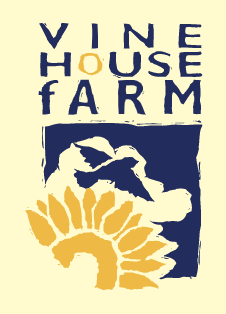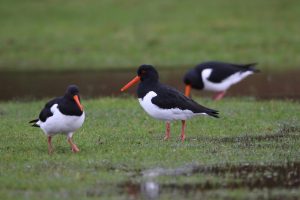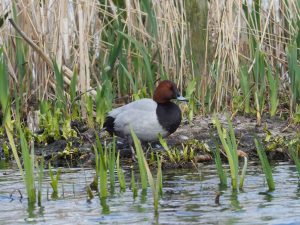
March has been by far the warmest March I have recorded, since I started my weather records in 1970. Temperatures reached an average of 8.75°C, 0.5° warmer than any other March and warmer than an average April. Rainfall has been slightly below average, 40mm fell. I expect we will have another cold snap later, when those birds that need insects will be feeding young.

The crops we planted last autumn are romping away, we have never seen oil seed rape in flower in March before. Reed Buntings are already taking up territory in the rape fields.
With fine weather forecasted, by the time you read this we will be planting potatoes and drilling sugar beet. There’s a lot of research each year into trying to find potato varieties that yield, taste, look and cook better. I believe that today’s varieties do all of those things and so we must move with the times. Sadly, those farmers who do not move with the times go backwards and eventually go out of business. So again, we will not be planting one of my favourite varieties – the King Edward. We used to get a price premium for them as they did not yield as well as other modern varieties. Sadly this does not happen very often now, so they are not as profitable as other varieties to grow. Instead we will be trying two new varieties, called Nectar and Tyson.
Potato planting forty years ago used to take every man on the farm. There would be two or three tractors preparing the ground before the planter, another tractor would be applying fertiliser and two or three people bringing the seed potatoes to the field, from the glasshouse. We used to have a three row planter and it would need three people to place the potatoes in each cup of the planter which, of course, was pulled by yet another tractor. Today we send one man with one large tractor to plant the potatoes. This tractor has a fertiliser applicator, a machine to prepare the ground with a planter on the back of that. If the ground is a bit heavy, we send another man to help prepare the ground in front of the planting tractor. One man part time, with the help of fork lifts, can bring the fertiliser and seed potatoes to the field.
We will soon be sowing canary seed in the same way we sow wheat or barley. The millet and sunflowers don’t want to be sown until about May 1st, as they are very prone to frosts.
Whilst feeding the birds in the winter is an easy job, feeding the birds in the summer is not so easy. We have to have a varied habitat to provide a variety of insects and that does not happen on our farms or in our gardens unless we make quite an effort all through the year.
A vegetable garden would have been a varied habitat but very few people grow vegetables now and our gardens in general are far less diverse than they used to be. All the crops on our farms would have had weeds in them making a diverse habitat but most of our crops don’t have any weeds in them. At this time of year we tend to those areas we are growing for insects, taking those weeds out that we don’t want, such as cleavers thistles and docks. Thistles are good for wildlife but if their seed blows on to our fields, it gets very expensive as we have to treat a whole field to control the thistles


Our summer visitors are now arriving. I have been hearing Chiffchaffs now for two weeks. For those who don’t know them, they are a classic ‘LBB’, a little brown bird. They are the easiest to identify by its song, which is a ‘chiff-chaff-chaff-chiff-chaff’ and then a short break, to grab a couple of small insects in the top of the tree it is singing in, before continuing. This time of the year is an excellent time to sharpen your bird song identification, especially before too many migrants arrive.
The Sand Martins are back in the sand heap we have in Langtoft Fen; about 30 birds have already started making nest holes. We are planning to put a new potato store up this summer and could have used that gravel for the foundations. Instead we brought contractors in to enlarge some small ponds, where there is a gravel subsoil, to extract more gravel. This has now been used to make the base of the new store, and the Sand Martin’s home is safe.
There are already young birds around, we have a Blackbird feeding young in our garden and I saw a Moorhen with three chicks. The warm weather has enabled these early nests to survive. Both these species are birds that will be having successive broods throughout the summer. The first brood could fail due to cold or a later brood could fail because of drought so by trying throughout the summer, they usually manage to rear some young.
Now is the time to start offering live mealworms. Studies have shown that 50% more birds will be reared in your garden, if you feed live mealworms. Every bird has to take its young moist food, it cannot take them water so water has to be included in the food and that moist food is either insects or unripe seeds. I get more enjoyment out of feeding mealworms than any other food, I feed them in a cage, so that the Starlings and Blackbirds cannot get them. The Starlings and Blackbirds aren’t neglected though – they are fed soaked sultanas in another cage that the Wood Pigeons can’t get in to. Sultanas can be poisonous to dogs however, if they eat too many, so a pinned down cage would keep a dog away.
If we want to see a lot of birds we have to breed a lot of birds and live mealworms will help us to do that. Birds need our help, as more than 50% of bird species are declining. If you have any queries about feeding live mealworms do ring, or email, us and we will be happy to help.
On April 2nd, I heard that bird watchers were looking for a Wheatear that had been seen on the North Norfolk coast. The Wheatear is a small bird that we used to see regularly on the farm in spring and autumn but now only see one or two a year. They breed in Scotland and up to the Arctic, then migrate back to Africa each winter. That is what we thought, however in the last few years, some Wheatears have been fitted with data loggers and some of these birds pass through the British Isles, go on to Siberia, across the Arctic ocean and breed in Alaska! Wildlife is amazing – we must look after it.
Talks, Walks and Events
Friday 21st April Old Barn Hall Community Centre
Amersham Bird Watching Club
Saturday 13th May Tree Sparrow Farm Walk
Saturday 20th May Farm Walk
Sunday 11th June Open Farm (Saturday 10th &) Sunday
at Park Farm, Thorney PE6 0SY
Saturday 17th June Farm Walk
Saturday 5th August Sunflower Farm Walk
Saturday 12th August Sunflower Farm Walk
Sunday 13th August Sunflower Farm Walk



